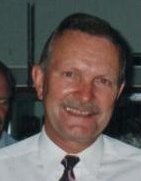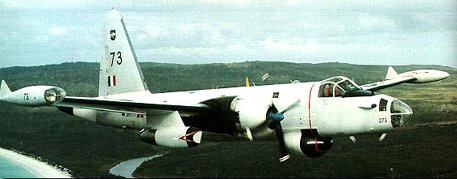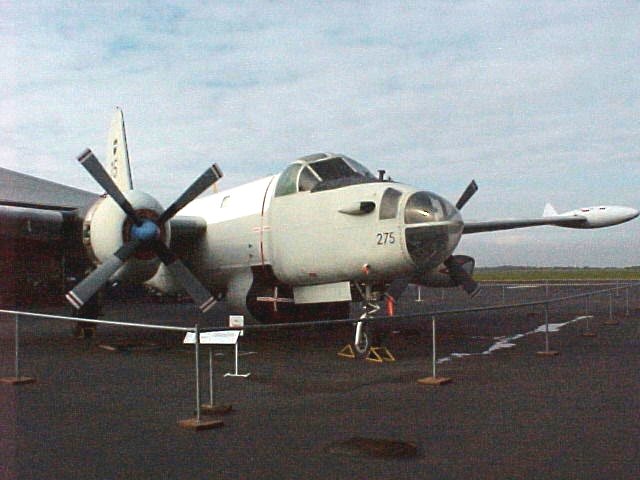|
|
||
|
|
Radschool Newsletter |
Vol 8 Page 4 |
|
|
||
|
The Lockheed Neptune.
The
Neptune can trace its maritime patrol ancestry back to the Lockheed
Hudson. Designed in 1938, the Hudson gradually revolved through
improvements into the PV-2 Harpoon, though even before the United
States’ entry into World War Two, it had become apparent that the US
Navy would need a land-based patrol bomber with greater range and
armament, higher level and climbing speeds and slower approach and
landing speeds than the Hudson and Harpoon. What the Navy needed was
an aircraft designed specifically for the primary mission of day and
night
Adrian Heinrich, who spent some time with 10 Sqn in Townsville recalls the Neptune ASW aircraft and his experiences with the Sqn.
The initial concept called for an aircraft with a gross weight of 25,000 to 35,000 lb, power operated turrets, tricycle landing gear and the ability to carry two torpedoes, bombs and depth charges internally. The favoured powerplants were a pair of eighteen cylinder Wright R-3550s producing 2,000 hp. Progress on the new patrol plane was slow as the US Navy needed proven aircraft during the critical months following the Japanese attack on Pearl Harbour, but by early 1943 the USN switched its procurement attention from acquiring immediately available aircraft, to supporting the development of newer and more capable types. One design feature of the new aircraft included the wing box running continuously through the fuselage. This also allowed the entire bomb bay load to be directly distributed throughout the wings, but made going from front to back on the inside damn difficult. The Neptune was also designed to be an easy and accessible aircraft to maintain, and supposedly a complete engine change could be accomplished in 30 minutes, a propeller in 22 minutes and an outer wing panel in 79 minutes.
In the spring of 1945, thirteen months after the initial contract was awarded, the Neptune was ready to fly.
The RAAF acquired and operated two different versions of the Neptune. 11 Sqn received their first 2 x P2V-5’s in 1951 with the remaining 10 being delivered in 1952. In 1961 it was decided to purchase twelve of the more modern P2V-7s for delivery to 10 Sqn in Townsville.
11 Squadron (Motto: Shepherd or Destroy) was formed at Richmond in March 1939 and equipped with Empire flying boats and Seagull amphibians. It was sent to Port Moresby where its was to monitor Japanese shipping movements in the region. After Japan’s entry in the War, 11 Squadron was re-equipped with Catalina flying boats and after losing a couple of aircraft in Moresby Harbour, it eventually withdrew to northern Australia.
For a while then, 11 Squadron moved all over Australia. In 1942, it was sent to Cairns where it conducted long-range patrols over the Coral Sea and the Pacific Ocean. In late 1944 the squadron moved again, this time to Rathmines, near Newcastle, New South Wales. From there it performed one of its most successful missions when three aircraft flew to the Philippines and mined Manila Harbour just before the invasion of Mindoro Island. Then in 1946, the squadron was disbanded, but reformed in 1948 and was subsequently equipped with Lincoln Mk.30 aircraft. The squadron again disbanded in 1950 at RAAF Amberley in Queensland and reformed that same year at RAAF Pearce. It was here in 1951 that the squadron began transition to the P2V-5 Neptune aircraft. The squadron then returned to its birthplace at Richmond in 1953 and operated from there for the next 14 years. In February 1957, three 11 squadron Neptunes participated in "Operation Westbound" - the RAAF's first around the world flight. Neptune aircraft were operated until 1968 when the Squadron moved to South Australia in January and was re-equipped with Orions later in the year. In 1970 Prince Phillip presented the squadron with its own standard for 25 years of meritorious service.
A89-312, (P2V-5) delivered to 11 Sqn in Nov 51, shown here at Richmond.
Lockheed produced more P2V-5 models than any other type. It was capable of carrying an 8,0001b load of mines, torpedoes, bombs or depth charges and sixteen rockets on under-wing launch stubs, which was later reduced to 8 with the addition of the Westinghouse J-34s jet engines. An APS-20 radar was mounted in the underbelly position just behind the nose wheel doors. The wing tip fuel tanks could carry an additional 350 gallons of fuel in each tank while the starboard wingtip tank housed a powerful searchlight with a moveable reflector and arc element. The whole thing was controlled by servomotors from the nose turret area. The port wingtip tank had an APS-31 search radar mounted in its forward portion. It carried a crew of nine, had a top speed of 341 mph and a range of 4,750 miles. Originally the aircraft were delivered to 11 Sqn without the Westinghouse J34 jet engines, however, in June 1959, the first Neppy (A89-302) was ferried to the USA for the installation, and was returned to No 11 Squadron in October that year.
10 Squadron, (Motto: Strike First) which formed at Point Cook in July 1939, was originally equipped with Sunderland flying boats, and set off for the UK to take possession of their aircraft. When war broke out, the Sqn remained in England where its main tasks included convoy escorts, anti submarine patrols and air sea rescue work. 10 Sqn was the only RAAF squadron to see continuous active service throughout the war.
After the war, the Sqn returned to Australia and was established in Townsville (Mar 49) where it was re-equipped with Lincoln's and given the task of patrolling Australia's northern waters and much of the Pacific Ocean - a massive area representing about one tenth of the world's surface. In March 1962, 10 Squadron received the first of its 12 Lockheed Neptunes, the P2V-7.
A89-275 (P2V-7) of 10 Sqn. The differences between aircraft type are evident in these photos.
The P2V-7 was the last of the Neptunes, having first flown in April, 1954. It was powered by 2 x 3,700HP Wright R-3,350 engines and 2 x J-34 turbo jet engines. It had a “dash” speed of 364 MPH with all engines running, making it the fastest of the model. The radome for the APS-20 radar was enlarged and moved forward, which enabled it to carry up to 10,000lbs in its larger weapons bay. The flight deck was raised and a redesigned canopy improved visibility. It had smaller auxiliary wing tanks and still retained the search light, though the APS-31 was dispensed with. In 1962 Lockheed ceased production of the Neptune, and the RAAF finally retired their last in 1979.
Major servicing (E’s) on the Neppies was carried out by the Depot Doggies at 2AD’s “Pentad” hanger at Richmond. 10 Sqn would remove a majority of the aircraft’s electronic equipment prior to sending their aircraft to 2AD, which left the Radio Doggies with not much to do, consequently, this was where radio mechanics attached to 2AD invariably found themselves learning the art of applying paint stripper to the skin of an aircraft (lovely job), or were taught such trades as how to “crackle black” a radio cabinet. (Shorty Core—where are you??).
Aircraft were ferried to Richmond for an “E” with only essential comms and nav gear as all of the ASW gear and the radar was removed before leaving Townsville. This was done to provide better access for the Depot doggies. It also provided a bonanza of spares for the other serviceable aircraft, the only problem being that the damn thing eventually came back and the gear had to be refitted. This usually (always) created a panic as most of it had been stuck in other aircraft; and once refitted getting the bugs out after cables and plugs had been disturbed sometimes took months. However, the aircraft looked good after an 'E'' even if it was basically useless for months afterwards.
If a policeman takes a sicky - is that called a cop out?
The Neptune was really a bitch of a plane to work on and fly in as it was cramped and hot, especially so in tropical Townsville. Every available bit of 'space' was taken up with 'black' boxes of some description and with all of this gear running the temperature inside was unbearable. I still remember lying flat out in the radar well under the floor and trying to fix the APS20 radar with it running and generating a ton of heat, often you would come out having lost pounds of weight in sweat, but this was quickly replaced at the boozer after work! Another memory is that of trying to perform a 'marriage' between the ASA13 nav computer system and the ASA16 sonobuoy drift and display computer system. This frustrating procedure involved hours of fiddling about with a Fluke differential voltmeter measuring millivolts to calibrate 'marry' the two systems; often having to replace components insitu to get it right. Naturally, it always seemed the radio blokes’ stuff was at fault, never the clockwinders (Instruments) and quite a lot of time was spent just convincing the clockies that is was actually their gear that was U/S. This made for a considerable amount of rivalry between the two trades and generally it was fairly good natured.
As anyone who worked on them knows only too well, the aircraft overall was quite unreliable and before launching on a long sortie the pilots naturally wanted to know that the engines were likely to keep going until they got back (funny people pilots—want everything). To aid their confidence they had a bit of gear called an Ignition Analyser which was monitored by a crew member during the run-up of the main engines. Invariably a plug or two would be fouled and the aircraft returned to dispersal for a quick plug change. The poor old sumpies were meant to do this on a red hot engine but often the aircrew would lend them their leather flying gloves, such was the camaraderie in the squadron, though why they weren’t provided with them by the RAAF beats me. We used to listen for the sound of the two jets starting after the main engine run-ups as this signified that they were probably going to go and we could relax for a few hours while it was away. The tell-tale squealing of the brakes instead of the jets, as it taxied back was enough to spoil your plans for a break. It usually involved the engines but sometimes there was a problem with the ASW gear and we had to try and fix things insitu to get them away again.
One of our more pleasant duties was as a cross-trained (Radio/Elec/Inst) support crew member on a long Navex around Australia, together with a cross-trained engine/airframe fitter. This usually involved overnighting in Perth, then on to Adelaide for another overnight, before flying back to Townsville, usually via East Sale. Sometimes we would go clockwise and go to Adelaide first, before Perth. I had my parents to visit in Adelaide and a good mate in Perth, so it was well worth the many hours spent in the air.
Some of the views around the country were spectacular when viewed from up in the glass nose of the Neppy and we always circled Ayers Rock to check out the tourists, sometimes we had a pilot who insisted on buzzing his home town along the way at tree top level, quite a thrill when you were in the nose I can tell you. More often than not the price for getting these trips was to bring back SA wine for the blokes in the squadron as you couldn't get any good wine in Townsville in those days. Sometimes the aircraft had a bomb bay pannier full of wine and every spare 'space' inside was filled as well. On one occasion the Captain got us to move some cases of wine up into the nose as it was dragging its tail.
A89-275, one of 10 Sqn’s Neppies, was received on 29 March 1962. This aircraft is now on display at the RAAF’s museum at Port Cook.
Overseas exercises were an experience with the Neppies, especially the one we did to Barbers Point Naval Air Station in Hawaii in 1969. We had as support an 'A' Model Hercules filled with flyaway kit and troops and this followed the Neppies via Guam and Wake Island. The problems along the way involved the Herc breaking down as well as the Neppies. The exercise was in full swing and we were working around the clock to keep our three aircraft serviceable, when our aircrew got a bit too accurate and sunk the U.S. Navy's torpedo retrieval vessel with a practice torpedo. This virtually ended the exercise and we were able to relax and enjoy the sights around Hawaii, trouble was our money ran out fast and this slowed us down a bit.
The yanks didn't really know how to take our lot, the Master at Arms was called to our block one night to break up a party and got quite upset with us when we laughed at the sight of this huge guy with chrome helmet and all sorts of shiny badges, gaiters, truncheon and all. He decided that it was too much for him and left it up to our corporals to get the place cleaned up and quieten down a bit, or else - we did and didn't hear another thing about it. On the way back to Australia we stopped again at Wake Island and Guam.
In Guam a few of us went with some yanks to a seedy district for a beer or two and it appeared it was off-limits, as the Navy Shore Patrol raided the place and arrested our yank mates, once again it was too hard for the yanks to deal with us so we were sent back to the base in a taxi. A couple of us were fearful of sleeping in and then having to hand back bedding etc first thing in the morning, so we got the bright idea to hand it in then and there and go down and sleep in the Herc. This was a great idea until we reached the tarmac and were confronted by an armed guard who refused us entry to the Herc.
After a bit of horse-trading we convinced this yank that we weren't going to pinch the Herc and that we only wanted to sleep in it, he relented and I woke up half-way back to Australia. I still have his truncheon and gas-proof torch as souvenirs and am told that I had his .45 pistol as well at one stage, but that he pleaded with me to at least leave that as he would probably do time in the stockade if he lost that.
There are many more stories I could tell about the time I spent working on Neppies in the North Queensland Air Force—and I will, and you can bet they’ll definitely be incriminating.
|
||
|
A drunk stumbles into the church and wobbles into the confessional. The priest hears him enter then it all goes quiet, so after a while he knocks on the wall. '' Forget it mate" slurs the drunk, "There's no bloody paper in this one either". |
||
|
Counter sine Mar 2017 |
||
|
|
||
|
|
||



